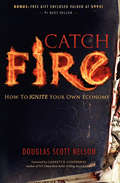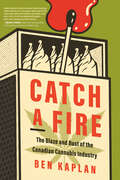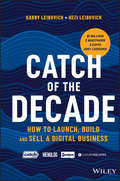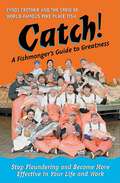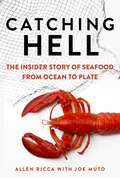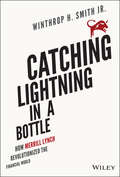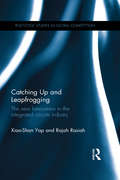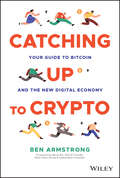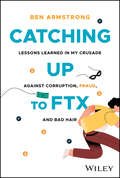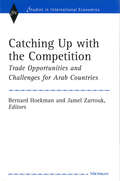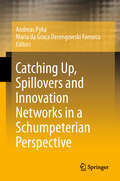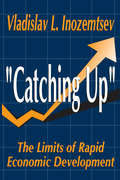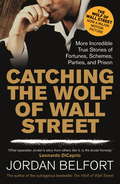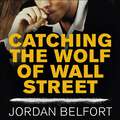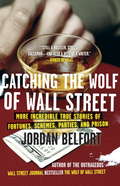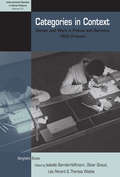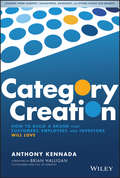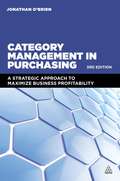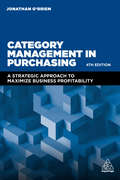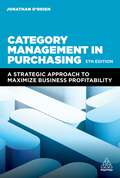- Table View
- List View
Catawba Industrial Co.
by Francis J. AguilarA department general manager has to decide whether or not to add a lightweight compressor to the line, what price to charge, and what volume to produce. The analysis requires maximizing contribution in a situation where one factor is constrained. As such, it takes into account opportunity costs and shadow prices as well as fixed and variable costs, demand curve analysis, and sunk costs. Also invites discussion about the proper measurement, offering departmental profits and return on sales as candidates.
Catch Fire: How to Ignite Your Own Economy
by Douglas Scott NelsonTake control of your life by becoming financially bulletproof with this no-holds-barred guide to money management. A tragic accident in 2002 nearly took Doug Nelson&’s life. Caught in a horrendous gas explosion, he spent six weeks in a coma and nine months rehabilitating from his injuries. But Doug was blessed—he knew that money would not be an issue during that difficult time. He had spent several years prior to the tragedy working toward, and achieving, financial freedom. In Catch Fire, Doug shares his amazing story and provides the simple tools and knowledge that can help you to achieve the same financial peace of mind. Doug debunks numerous money myths and explains how to make money work for rather than against you. His Financial Playbook provides the offensive and defensive strategies necessary to securing your economic future and pursuing your life&’s true purpose. &“Financial freedom is a goal many chase after, but you won't have to chase any longer after reading this book. You will be equipped and on fire to make some serious changes in your financial life.&” —T. Harv Eker, bestselling author of Secrets of the Millionaire Mind
Catch a Fire: The Blaze and Bust of the Canadian Cannabis Industry
by Ben Kaplan“Sharply observed, fiercely researched, starkly revealing, written with wit, verve, and insight, making room for the tragic ironies without ever taking its eyes off the comic ones, Catch a Fire left me shaking with laughter — when I wasn’t shaking my head in dismay.” — MICHAEL CHABONThe untold story of the $131-billion Canadian cannabis blow out.Canopy Growth founder Bruce Linton didn’t invent marijuana, but he figured out how to turn a Canadian start-up selling the stuff into a $22 billion international buzz. Catch a Fire goes behind the scenes of Justin Trudeau’s legalization gambit and the stoned pioneering lawyers who helped make weed gummies more valuable than U.S. Steel. From the dope dealers of the 1960s to the never-before-told bribery accusations during Covid-19, cannabis historian Ben Kaplan speaks with the dealers, stealers, and renegade freaks who made and then lost money with the combined chutzpah of Jeff Bezos, Elon Musk, and Sam Bankman-Fried.This is the definitive history of a massive societal change — and a great boom and bust.
Catch of the Decade: How to Launch, Build and Sell a Digital Business
by Gabby Leibovich Hezi Leibovich‘Gabby and Hezi were always the most looked-up-to duo in ecommerce and they truly taught me how to trade!’ Nick Molnar, CEO, Afterpay ‘The Leibovich brothers are pioneers of Australian ecommerce. You cannot afford to not read this book.’ Christine Holgate, Group Chief Executive Officer & Managing Director, Australia Post Real stories and advice from digital entrepreneurs who have learned what it takes to succeed In Catch of the Decade, two of Australia’s most successful online superstars reveal how they’ve built, launched, merged, and sold some of the most disruptive businesses in Australia today: Catch, Scoopon, Menulog and Luxury Escapes. This book contains little-known secrets and strategies that will help you shorten your learning curve, avoid mistakes, and bring your business dream alive. The wisdom revealed in this book is hard won: brothers Gabby and Hezi Leibovich started with no money and no connections, turned their drawbacks into assets, and came out on top. You’ll learn how they rode the waves of entrepreneurialism and worked their way up. Learn proven tips to define, disrupt and dominate a sector or industry, straight from entrepreneurs who achieved their billion-dollar dreams. Read hard hitting, no bull nuggets of wisdom in the areas of customer service, PR, Buying and trading, engaging investors and more. Market-tested strategies for building big brands, creating high-performing teams and fostering a world-class entrepreneurial culture. For the first time, the Leibovich brothers are telling their story, in their own words, and you’ll learn how they got where they are today. Follow in their footsteps with over 200 bite-sized entries that are both inspirational and useful. Pick up Catch of the Decade and get moving!
Catch the Fire
by Charlie Murphy Peggy TaylorCommunity, youth, nonprofit, education, entrepreneurial, and religious organizations all have exciting ambitions, but they often lack the creative skills to impact people on a deeper level. Catch the Fire is a complete guide to using arts and empowerment techniques to bring greater vitality and depth to working with groups of youth or adults. Based on the premise that you don't have to be a professional artist to use the arts in your work, this unique book invites group leaders into the realm of creativity-based facilitation, regardless of previous experience.Including over one hundred stimulating activities incorporating storytelling, theater, writing, visual arts, music, and movement, this detailed guide uses the Creative Community Model to:Bridge gaps and unite people across generations and culturesBuild vibrant, creative learning communities with youth and/or adultsFully engage participants and volunteersDevelop social and emotional intelligenceTake a deeper, more meaningful approach to learningDrawing on nearly two decades of experience providing transformative programs to empower youth and adults across North America and around the world, Catch the Fire is a powerful and valuable resource and a much-needed reminder that art is for everyone!Peggy Taylor and Charlie Murphy are co-founders of PYE Global: Partners for Youth Empowerment and developers of the Creative Community Model, a process for building creative, heart-centered learning communities with youth and adults from diverse cultures and socio-economic backgrounds. Peggy is co-author of Chop Wood, Carry Water: A Guide to Finding Spiritual Fulfillment in Everyday Life which sold over 250,000 copies worldwide.
Catch!: A Fishmonger's Guide to Greatness
by Cyndi CrotherSeattle locals and tourists alike flock to Pike Place each day to watch the fish fly. But Pike Place Fish is about more than just crowd-pleasing entertainment --- there is an underlying philosophy at work that has made the market both wildly successful and internationally renowned. In an unusual combination of oral biography and practical business blueprint, Crother and the fishmongers take you behind the scenes at the famous market to illustrate the PPF philosophy and reveal the underlying assumptions that have made PPF the international phenomenon it is today. Catch! shows that to be "ordinary" is to be a victim of circumstances, responding to whatever comes one's way. To be "great" is to realize that anyone can live an extraordinary life. At Pike Place Fish, everyone is responsible for transforming themselves from ordinary to great by creating their own reality. The authors explore the issues of goals --- financial, personal and humanitarian --- and intention, showing how the crew itself creates these goals and works towards them in collaboration. Most importantly, Catch! examines the power of possibility and shows how you can achieve greatness in your own life. Catch! explores such guiding principles as coaching and acknowledgment that are lacking in many businesses, and shows that you, too, can be the prime mover in your own experience.
Catching Hell: The Insider Story of Seafood from Ocean to Plate
by Joe Muto Allen RiccaIn Catching Hell, longtime seafood mogul Allen Ricca and author Joe Muto take readers behind the scenes of the high-end restaurant world and the international market for seafood, and how that industry has been impacted perhaps like no other due to the COVID-19 pandemic.This book exposes the fact that the American diner is being lied to on a regular basis. The culprit varies – sometimes it&’s a chef or restaurant owner trying to cut corners to save money; other times it&’s an unscrupulous supplier looking to pass off poor product to an unwitting receiver. And the cost of that scam eventually gets passed on to the consumer, whether it be in the form of higher prices at restaurants and markets, lower quality (or even counterfeit) product getting delivered onto your plate, or – God forbid – food poisoning. Furthermore, Ricca argues, the pandemic has only increased corruption in this industry.This book serves as both an exposé and a call to arms, empowering consumers with the knowledge to make more informed choices when dining out. Some of the things this explosive book reveals:The one fish you should never order, one that&’s always a rip-off. (And the one fish that&’s always a delicious, virtually-unknown bargain.)Why restaurants that advertise &“fresh&” fish are almost always lying.How to get your favorite restaurant to treat you like royalty – without dropping thousands of dollars.How the covid-19 pandemic has impacted our food supply chain and what it has meant for the everyday worker.
Catching Lightning in a Bottle
by Winthrop H. Smith JrThe fascinating story behind the company that revolutionized the financial world Catching Lightning in a Bottle traces the complete history of Merrill Lynch and the company's substantial impact on the world of finance, from the birth of the once-mighty company to its inauspicious end. Throughout its ninety-four year history, Merrill Lynch revolutionized finance by bringing Wall Street to Main Street, operating under a series of guidelines known as the Principles. These values allowed the company to gain the trust of small investors by putting the clients' interests first, driving a business trajectory that expanded capital markets and fueled the growth of the American post-war economy. Written by the son of Merrill Lynch co-founder Winthrop H. Smith, this book describes the creation and evolution of the company from Charlie Merrill's one-man shop in 1914 to its acquisition by Bank of America in 2008. Author Winthrop H. Smith Jr. spent twenty-eight years at the company his father co-founded, bringing a unique perspective to bear in telling the story of the company that democratized the stock market and eventually fell from its lofty perch. Learn why the industry initially scoffed at Charles Merrill's "radical" investment ideas Discover the origin of the Principles, and how they drove operations for nearly a century Find out why the author left a successful Wall Street career, and why it was such a smart move Examine the culture and values that built Merrill Lynch into one of the world's most successful and respected companies Revolutionary vision is rare, and enduring success is even more so. When a single organization demonstrates both of those characteristics, it is felt throughout the world. Discover the fascinating story behind Merrill Lynch and the men who built it from an insider's perspective in Catching Lightning in a Bottle.
Catching Up and Leapfrogging: The new latecomers in the integrated circuits industry (Routledge Studies in Global Competition)
by Rajah Rasiah Xiao-Shan YapEver since Schumpeter’s groundbreaking work there has been a plethora of new research seeking to extend the direction and dynamics of innovation. Using a rich account of detailed interviews, this book offers new evidence on how latecomers have successfully caught up and leapfrogged incumbent firms. Catching Up and Leapfrogging: the new latecomers in the integrated circuits industry explores how technological transitions affect latecomer catch-up strategies, and vice versa, in a high technology industry. It looks to the East Asian latecomers who, towards the end of the twentieth century, pioneered a new pathway through organizational change by specializing in the key production stages of integrated circuits and pushing technologies further. This volume assesses how latecomer resource acquisition strategies have varied alongside structural industry changes and evaluates the mechanisms through which firms started life as technology followers and rose to become technology leaders. Xiao-Shan Yap and Rajah Rasiah present a unique story about how firm strategies evolve from the catching up phase to the leapfrogging phase, captured from the accounts of managers on the ground. It is the first time firm-level strategies have been systematically analysed to describe twenty-first century strategic management in the integrated circuits industry in particular, and the high tech industry in general. The evidence and analysis in this book offers insights for chief executive officers, policy-makers and researchers to revisit existing approaches to the theory of catching up and leapfrogging.
Catching Up to Crypto: Your Guide to Bitcoin and the New Digital Economy
by Ben ArmstrongA fun and authoritative guide to bitcoin and the future of money In Catching Up to Crypto: Your Guide to Bitcoin and the New Digital Economy, celebrated crypto and Bitcoin expert Ben Armstrong delivers an exciting and fresh new exploration of Bitcoin and digital currencies. He explains what Bitcoin is, how it works, and how and why we’re all transitioning to a digital economy as we speak. He discusses the deficiencies of traditional fiat currency, how it’s commonly manipulated, and how we can all benefit from the adoption of new, digital assets. In the book, you’ll discover how Bitcoin operates in the real-world and how the underlying technology—known as the blockchain—operates. You’ll also learn about: The importance of decentralization, trust-less commerce and cryptographic consensus. The humble origins of Bitcoin, as well as how it nearly died out, and how it went on to take over the world How monetary and financial policy is being revolutionized by the introduction of Bitcoin and other crypto-assets.An essential and engaging review of Bitcoin, digital assets, and the new digital economy, Catching Up to Crypto is the hands-on and comprehensive introduction to crypto that investors, enthusiasts, the crypto-curious, and finance professionals have been waiting for.
Catching Up to FTX: Lessons Learned in My Crusade Against Corruption, Fraud, and Bad Hair
by Ben ArmstrongDiscover the secret history of Alameda Research, FTX, and Sam Bankman-Fried In Catching Up To FTX: Lessons Learned In My Crusade Against Corruption, Fraud, and Bad Hair, celebrated YouTuber and podcaster Ben Armstrong delivers the extraordinary and compelling story of the rise and fall of FTX and its well-known founder Sam Bankman-Fried. Tracking the history of crypto exchanges from the original Mt. Gox to FTX and Binance, the author describes the history of fraud that has characterized much of the industry. Armstrong outlines the history of Alameda Research, FTX, and Sam Bankman-Fried, including a first-hand account of what he saw in the Bahamas when the indicted crypto titan was extradited from his home to face dozens of criminal and regulatory charges in the United States. He also discusses: The weird and contradictory motives that drove Sam Bankman-Fried's brazen actions A blow-by-blow account of the downfall of Alameda Research, FTX, and Sam Bankman-Fried The red flags that many ignored — and a few didn't — that preceded the collapse of FTX The perfect book for anyone interested in crypto, finance, and corporate scandal, Catching Up To FTX will earn a spot on the bookshelves of everyone looking for an intense rollercoaster of a true story.
Catching Up with the Competition
by Bernard Hoekman Jamel ZarroukAt a time when countries in the Middle East and North Africa (MENA) are joining the World Trade Organization, the lack of an economically sound analysis of trade policies in the region is especially notable. This volume remedies the situation by bringing together a distinguished group of applied trade economists to provide a broad view of the state of trade in and among the region's nations. The contributors provide original empirical analyses on key reform issues, and their work reflects deep knowledge of government concerns and policies. Part 1 sets the scene by comparing the performance of the MENA region with the rest of the world on a large number variables and indicators. Part 2 contains a number of CGE model-based analyses of trade policy reform options. Part 3 focuses on specific policy areas: standards as nontariff barriers and red tape, trade facilitation, an assessment of the impact of protecting intellectual property using partial equilibrium techniques, and a review of the existing Euro-Med agreements. Part 4 discusses how the region could benefit from WTO membership and from changing the existing regional integration schemes into arrangements that help promote a growth enhancing reform agenda.
Catching Up, Spillovers and Innovation Networks in a Schumpeterian Perspective
by Andreas Pyka Maria da Derengowski FonsecaThis book discusses the influence of technological and institutional change on development and growth, the impact on innovation of labor markets, the spatial distribution of innovation dynamics, and the meaning of knowledge generation and knowledge diffusion processes for development policies. The individual articles demonstrate the powerful possibilities that emerge from the toolkit of evolutionary and Schumpeterian economics. The book shows that evolutionary economics can be applied to the multi-facetted phenomena of economic development, and that a strong orientation on knowledge and innovation is key to development, especially in less developed and emerging economies.
Catching Up: The Limits of Rapid Economic Development
by Vladislav InozemtsevDisparities between the economic development of nations have widened throughout the twentieth century, and they show no sign of closing. In the nineteenth century, the economic potential of developed countries was three times that of the rest of the world. Today the gap is twenty times greater, and the trend is increasing. In this provocative reexamination of theories of accelerated development, or "catching up," Vladislav L. Inozemtsev traces the evolution of thinking about how countries lagging behind can most swiftly move forward, and assesses their prospects for success in this effort.Inozemtsev reviews the experience of the Soviet Union, as well as the recent experience of Japan, China, and Southeast Asia. He finds that those countries that have moved forward most rapidly have successfully adapted new technology to old processes. But even then, they face daunting odds, as they grapple with the need to change their population's ideas and behavior. And in the 1990s, their rates of development have noticeably declined. "Catching Up" assesses prospects for successful application of theories of accelerated development in the global economy. Inozemtsev's pessimistic conclusion is that rapid industrial progress is not achievable in the information society of the twenty-first century.Inozemtsev reaches this conclusion after reviewing theories of accelerated development thinking from the diverse viewpoints of the 1940s and 1950s, to the more intensive ideological polarization of the 1960s. Inozemtsev believes it will be impossible for non-Western nations to "catch up" with the West because of their inability to generate or control information and knowledge.
Catching the Wolf of Wall Street: More Incredible True Stories of Fortunes, Schemes, Parties, and Prison
by Jordan BelfortIn the 1990s Jordan Belfort became one of the most infamous names in American finance: a brilliant, conniving stock-chopper. He was THE WOLF OF WALL STREET, whose life of greed, power and excess was so outrageous it could only be true; no one could make this up! But the day Jordan was arrested and taken away in handcuffs was not the end of the madness.Catching the Wolf of Wall Street tells of what happened next. After getting out of jail on $10 million bail he had to choose whether to plead guilty and act as a government witness or fight the charges and see his wife be charged as well. he cooperated.With his trademark brash, brazen and thoroughly unputdownable storytelling, Jordan details more incredible true tales of fortunes made and lost, money-making schemes, parties, sex, drugs, marriage, divorce and prison.PRAISE FOR THE WOLF OF WALL STREET'What separates Jordan's story from others like it, is the brutal honesty.' - Leonardo DiCaprio'Raw and frequently hilarious.' - The New York Times'Reads like a cross between Tom Wolfe's Bonfire of the Vanities and Scorsese's Goodfellas ... Laugh-out funny.' - The Sunday Times
Catching the Wolf of Wall Street: More Incredible True Stories of Fortunes, Schemes, Parties, and Prison
by Jordan BelfortListen to what happened next in the follow-up to the bestselling The Wolf of Wall Street, now a major motion picture directed by MARTIN SCORSESE, starring LEONARDO DICAPRIO, MATTHEW MCCONAUGHEY, JONAH HILL, JEAN DUJARDIN, KYLE CHANDLER and JOANNA LUMLEY.In the 1990s Jordan Belfort became one of the most infamous names in American finance: a brilliant, conniving stock-chopper. He was THE WOLF OF WALL STREET, whose life of greed, power and excess was so outrageous it could only be true; no one could make this up! But the day Jordan was arrested and taken away in handcuffs was not the end of the madness.Catching the Wolf of Wall Street tells of what happened next. After getting out of jail on $10 million bail he had to choose whether to plead guilty and act as a government witness or fight the charges and see his wife be charged as well. he cooperated.With his trademark brash, brazen and thoroughly unputdownable storytelling, Jordan details more incredible true tales of fortunes made and lost, money-making schemes, parties, sex, drugs, marriage, divorce and prison.PRAISE FOR THE WOLF OF WALL STREET'What separates Jordan's story from others like it, is the brutal honesty.' - Leonardo DiCaprio'Raw and frequently hilarious.' - The New York Times'Reads like a cross between Tom Wolfe's Bonfire of the Vanities and Scorsese's Goodfellas ... Laugh-out funny.' - The Sunday Times(P)2009 Blackstone Audio Inc.
Catching the Wolf of Wall Street: More Incredible True Stories of Fortunes, Schemes, Parties, and Prison (The Wolf of Wall Street #2)
by Jordan BelfortIn this astounding account, Wall Street's notorious bad boy--the original million-dollar-a-week stock chopper--leads us through a drama worthy of The Sopranos, from the FBI raid on his estate to the deal he cut to rat out his oldest friends and colleagues to the conscience he eventually found. With his kingdom in ruin, not to mention his marriage, the Wolf faced his greatest challenge yet: how to navigate a gauntlet of judges and lawyers, hold on to his kids and his enraged model wife, and possibly salvage his self-respect. It wasn't going to be easy. In fact, for a man with an unprecedented appetite for excess, it was going to be hell. But the man at the center of one of the most shocking scandals in financial history soon sees the light of what matters most: his sobriety, and his future as a father and a man.
Categorical Data Analysis for the Behavioral and Social Sciences
by Razia Azen Cindy M. WalkerFeaturing a practical approach with numerous examples, the second edition of Categorical Data Analysis for the Behavioral and Social Sciences focuses on helping the reader develop a conceptual understanding of categorical methods, making it a much more accessible text than others on the market. The authors cover common categorical analysis methods and emphasize specific research questions that can be addressed by each analytic procedure, including how to obtain results using SPSS, SAS, and R, so that readers are able to address the research questions they wish to answer. Each chapter begins with a "Look Ahead" section to highlight key content. This is followed by an in-depth focus and explanation of the relationship between the initial research question, the use of software to perform the analyses, and how to interpret the output substantively. Included at the end of each chapter are a range of software examples and questions to test knowledge. New to the second edition: The addition of R syntax for all analyses and an update of SPSS and SAS syntax. The addition of a new chapter on GLMMs. Clarification of concepts and ideas that graduate students found confusing, including revised problems at the end of the chapters. Written for those without an extensive mathematical background, this book is ideal for a graduate course in categorical data analysis taught in departments of psychology, educational psychology, human development and family studies, sociology, public health, and business. Researchers in these disciplines interested in applying these procedures will also appreciate this book’s accessible approach.
Categorically Unequal: The American Stratification System
by Douglas S. MasseyThe United States holds the dubious distinction of having the most unequal income distribution of any advanced industrialized nation. While other developed countries face similar challenges from globalization and technological change, none rivals America's singularly poor record for equitably distributing the benefits and burdens of recent economic shifts. In Categorically Unequal, Douglas Massey weaves together history, political economy, and even neuropsychology to provide a comprehensive explanation of how America's culture and political system perpetuates inequalities between different segments of the population. Categorically Unequal is striking both for its theoretical originality and for the breadth of topics it covers. Massey argues that social inequalities arise from the universal human tendency to place others into social categories. In America, ethnic minorities, women, and the poor have consistently been the targets of stereotyping, and as a result, they have been exploited and discriminated against throughout the nation's history. African-Americans continue to face discrimination in markets for jobs, housing, and credit. Meanwhile, the militarization of the U. S. -Mexican border has discouraged Mexican migrants from leaving the United States, creating a pool of exploitable workers who lack the legal rights of citizens. Massey also shows that women's advances in the labor market have been concentrated among the affluent and well-educated, while low-skilled female workers have been relegated to occupations that offer few chances for earnings mobility. At the same time, as the wages of low-income men have fallen, more working-class women are remaining unmarried and raising children on their own. Even as minorities and women continue to face these obstacles, the progressive legacy of the New Deal has come under frontal assault. The government has passed anti-union legislation, made taxes more regressive, allowed the real value of the federal minimum wage to decline, and drastically cut social welfare spending. As a result, the income gap between the richest and poorest has dramatically widened since 1980. Massey attributes these anti-poor policies in part to the increasing segregation of neighborhoods by income, which has insulated the affluent from the social consequences of poverty, and to the disenfranchisement of the poor, as the population of immigrants, prisoners, and ex-felons swells. America's unrivaled disparities are not simply the inevitable result of globalization and technological change. As Massey shows, privileged groups have systematically exploited and excluded many of their fellow Americans. By delving into the root causes of inequality in America, Categorically Unequal provides a compelling argument for the creation of a more equitable society. A Volume in the Russell Sage Foundation's Centennial Series
Categories in Context: Gender and Work in France and Germany, 1900–Present (International Studies in Social History #31)
by Isabelle Berrebi-Hoffmann Olivier Giraud Léa Renard Theresa WobbeDespite the wealth of empirical research currently available on the interrelationships of gender and labor, we still know comparatively little about the forms of classification and categorization that have helped shape these social phenomena over time. Categories in Context seeks to enrich our understanding of how cognitive categories such as status, law, and rights have been produced, comprehended, appropriated, and eventually transformed by relevant actors. By focusing on specific developments in France and Germany through a transnational lens, this volume produces insights that can be applied to a wide variety of political, social, and historical contexts.
Category Creation: How to Build a Brand that Customers, Employees, and Investors Will Love
by Anthony KennadaLessons from HubSpot, Salesforce, Gainsight and Other Iconic Brands "The Uber of this" "The Salesforce of that" "It's like Instagram, but for…" There is no such thing as an original idea anymore – right? Actually, it turns out that the world’s most innovative companies have created so much more than just brand new products and technology. They've created entirely new market categories. The challenge is that successfully building new categories requires a perfect storm of luck and timing. Or does it? Category Creation is the first and only book on the topic written by executives and marketers actively building new categories. It explains how category creation has become the Holy Grail of marketing, and more importantly, how it can be planned and orchestrated. It's not about luck. You can use the same tactics that other category-defining companies have used to delight customers, employees, and investors. There’s no better strategy that results in faster growth and higher valuations for the company on top. Author Anthony Kennada, former Chief Marketing Officer at Gainsight, explains how he led Gainsight in creating the “customer success” category, and shares success stories from fellow category-creators like Salesforce, HubSpot and others. It requires much more than just having the best product. You have to start and grow a conversation that doesn’t yet exist, positioning a newly discovered problem in addition to your company and product offerings. The book explains the 7 key principles of category creation, including the importance of creating a community of early adopters who will rally around the problem they all share—especially if someone will lead them. · Identify the “go” and “no go” signals for category creation in your business · Activate customers and influencers as brand ambassadors · Grow a community by investing in live events and experiences · Prove the impact of category creation investments on growth, customer success, and company culture Written for entrepreneurs, marketers, and executives from startups to large enterprises, Category Creation is the exclusive playbook for building a category defining brand in the modern economy.
Category Management in Purchasing
by Jonathan O'BrienCategory Management in Purchasing is a comprehensive guide to strategic category management, providing a step-by-step guide to its implementation and use. This book provides the necessary tools, techniques and applications that will enable the reader to implement this cost saving purchasing method. The 3rd Edition of Category Management in Purchasing has been rigorously updated to reflect latest thinking in the field. Jonathan O'Brien shows how a strategic approach needs to work effectively together with other approaches, such as Supplier Relationship Management. He has added important sections on governance, included more supplier and supply chain tools, and introduced a pragmatic route for smaller businesses or those who need step-by-step advice. The book provides case studies of real companies, including: IKEA, The Body Shop, NHS, Heinz, Cardiff Council, and GlaxoSmithKline.
Category Management in Purchasing: A Strategic Approach to Maximize Business Profitability
by Jonathan O'BrienCategory Management in Purchasing is a comprehensive guide to strategic category management which provides a step-by-step guide to its implementation and use, and enables readers to deliver value and cost savings when sourcing and purchasing. Now in its fourth edition, this text has cemented its place as the essential reference for category management practitioners. In this new edition, Jonathan O'Brien shows how a strategic approach needs to integrate with other approaches, such as supplier relationship management and how the procurement function negotiates. Additionally, this new edition includes some new insights, based upon the experience of senior practitioners in industry, on how to make category management a success in the organization. It also includes some general updates and contextualizes the future procurement function and an ever increasing digitally enabled, de-globalized, post Brexit world. There is also additional material on the effect of international developments on procurement, updated tools and templates, and examples of how these have been successfully used in industry. Category Management in Purchasing, 4th edition connects theory and practice and provides readers with the tools to analyze complex sourcing situations quickly and clearly, and so develop innovative and creative proposals for sourcing.
Category Management in Purchasing: A Strategic Approach to Maximize Business Profitability
by Jonathan O'BrienApproach purchasing and procurement strategically, effectively and sustainably, with this comprehensive and practical guide to category management.Category Management in Purchasing equips those working in procurement with the tools they need to ensure effective procurement in an ever changing landscape. Combining practical advice and theory, this essential resource is crucial for developing successful purchasing strategies. Covering new technology-driven approaches to category management, this new edition outlines digital transformations and technological advancements, from digital sourcing platforms to new tools and systems.This edition also provides readers with the knowledge to approach complex sourcing situations not only effectively, but also sustainably. Including new guidance on how organizations and businesses can implement sustainability into their procurement strategies, Jonathan O'Brien recontextualizes category management in a time when responsible sourcing is more important than ever. This highly regarded and essential text provides what everyone in procurement needs when striving to make category management a reality.
Caterpillar Tractor Co.
by U. Srinivasa Rangan Christopher A. BartlettDescribes the structure and evolution of the earth moving equipment industry worldwide in the post war era, particularly focusing on developments in the 1960s and 1970s. Describes Caterpillar's strategy in becoming the dominant worldwide competitor (industry market share exceeding 50%). Includes details on CAT's manufacturing, marketing research and development, and organizational policies. Concludes with a description of some environmental changes occurring in the early 1980s, and raises the question of how these might effect Caterpillar Tractor Co.'s record 1981 performance and require changes in its highly successful strategy.

